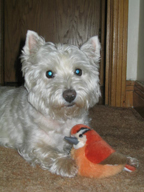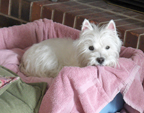Barking Solutions
People with terriers get used to some barking and tune it out for the most part. In our house the issue came to a head about a year ago. The two girls had long before decided to leave the barking job up to Toby as he did such a fine job of it, and took his duty very seriously. Now I had trained Toby to be quiet on command , but I was a fizzle at getting through to him that that meant for the whole afternoon, not just for that particular sound. He also let me know however that there were certain barking objects that were non-negotiable. These included all birds (we have bird houses, feeders and bird baths in our yard), the boys playing basketball across the street, and most of all, the silver dragon which roams over our neighbourbood every Wednesday morning picking up trash trolleys and dumping them on its back. This means I was often at him to be quiet, while the girls would sit by looking superior. One day I saw what I thought was clouds of spray drifting into the back yard, so I put the dogs inside and went to investigate. It was only a water pressure paint remover, but the neighbour identified me as the person with the barking dog and was 'not amused'. A solution had to be found, and quickly. I decided to explore my options.
The options:
• More training - not time enough and I doubted the reliability of that with Toby.
• Re-home the dog - not an option for me, although for some it could be a good solution. Westies have been bred to work in packs and have barking as a communication skill built into their make-up.
• Take the dog on leash every time it goes out. This is very demanding of the owner's time and can easily result in not enough exercise for the dog, unless the owner gets his exercise by walking.
• The electric collar - these give electric shocks ranging from mild to strong (depending on how you define 'mild' and 'strong'). The questions are: Do you as a Westie owner want to use electricity to shock your dog? What will it do to the dog's personality? Is this good training, or a form of cruelty? Knowing that all dogs can be trained more easily and efficiently without any form of punishment, I personally rejected this option.
• Sound Collar - these use electricity to produce a high-pitched sound (not audible to people) for the 'startle' effect.
• The Citronella Collar - this collar emits a puff of citronella - yes, the same lemon scent as in your bug repellent and candles. It claims to be effective, environmentally safe and safe for the dog. These are available through many veterinary clinics.
• De-bark the dog - this is done by a vet and barring complications of the surgery, allows the dog to make only a quiet gutteral sound, similar to someone with a very sore throat; and that is for life. I talked to a Sheltie breeder who said she uses this for her show dogs, and is pleased with the results. The questions here are: Do you want to risk possible surgical complications? Do you want that sound from your pet for the rest of its life? Will that sound be loud enough to warn you of a fire in the middle of the night? How will you feel when he 'barks' like that for your friends? What will such an operation cost as you may well be sent to a specialist vet?
As you can see, there are several solutions and some serious thought needs to be put into making the best possible decision. After talking with my vet, I decided on the Citronella Collar. (I always have liked the smell.) I put it on Toby, popped him outside and watched to see what would happen. It didn't take long. He jumped back, shaking his head and looking for who or what had done that. The second time he barked he knew the bark had caused the 'awful' smell. A year has passed now. Our dogs wear these collars when they're in the yard, and there's no barking. I allow my dogs to bark in the house as it's their job to alert me to people coming or anything unusual. They're quite content now on Wednesday mornings to snooze in the sun and let other dogs in the nieghbourhood drive away the dragon.
For more information see our book page.
Author: Anne Matheson.


